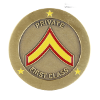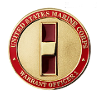Jerry Michael “Mad Dog” Shriver
1941-1969 MACV-SOG Master Sergeant
I love his quote “ It was Jerry Shriver
who’d spoken the most famous rejoinder in SOG history, radioing
his superiors not to worry that NVA forces had encircled his tiny
team. “No, no,” he explained, “I’ve got ’em right where I want ’em
— surrounded from the inside.”
i can share some links if you want
”
SFC Jerry M. “Mad Dog” Shriver was a legendary Green Beret. He was an exploitation platoon leader with Command and Control South, MACV-SOG Military Assistance Command, Vietnam Studies and Observation Group). MACV-SOG was a joint service high command unconventional warfare task force engaged in highly classified operations throughout Southeast Asia. The 5th Special Forces channeled personnel into MACV-SOG (although it was not a Special Forces group) through Special Operations Augmentation (SOA), which provided their “cover” while under secret orders to MACV-SOG. The teams performed deep penetration missions of strategic reconnaissance and interdiction which were called, depending on the time frame, “Shining Brass” or “Prairie Fire” missions.
On the morning of April 24, 1969, Shriver’s hatchet platoon was air assaulted into Cambodia by four helicopters. Upon departing the helicopter, the team had begun moving toward its initial target point when it came under heavy volumes of enemy fire from several machine gun bunkers and entrenched enemy positions estimated to be at least a company-sized element.
Shriver was last seen by the company commander, Capt. Paul D. Cahill, as Shriver was moving against the machine gun bunkers and entering a tree line on the southwest edge of the LZ with a trusted Montagnard striker. Capt. Cahill and Sgt. Ernest C. Jamison, the platoon medical aidman, took cover in a bomb crater. Cahill continued radio contact with Shriver for four hours until his transmission was broken and Shriver was not heard from again. It was known that Shriver had been wounded 3 or 4 times. An enemy soldier was later seen picking up a weapon which appeared to be the same type carried by Shriver.
Jamison left the crater to retrieve one of the wounded Montagnards who had fallen in the charge. The medic reached the soldier, but was almost torn apart by concentrated machine gun fire. At that moment Cahill was wounded in the right eye, which resulted in his total blindness for the next 30 minutes. The platoon radioman, Y-Sum Nie, desperately radioed for immediate extraction.
Maj. Benjamin T. Kapp, Jr. was in the command helicopter and could see the platoon pinned down across the broken ground and rims of bomb craters. North Vietnamese machine guns were firing into the bodies in front of their positions and covering the open ground with grazing fire. The assistant platoon leader, 1Lt. Gregory M. Harrigan, reported within minutes that half the platoon was killed or wounded. Harrigan himself was killed 45 minutes later.
Helicopter gunships and A1E aircraft bombed and rocketed the NVA defenses. The heavy ground fire peppered the aircraft in return, wounding one door gunner during low-level strafing. Several attempts to lift out survivors had to be aborted. Ten airstrikes and 1,500 rockets had been placed in the area in attempts to make a safe extraction possible. 1Lt. Walter L. Marcantel, the third in command, called for napalm only ten yards from his frontline, and both he and his nine remaining commandos were burned by splashing napalm.
After seven hours of contact, three helicopters dashed in and pulled out 15 wounded troops. As the aircraft lifted off, several crewmen saw movement in a bomb crater. A fourth helicopter set down, and Lt. Daniel Hall twice raced over to the bomb crater. On the first trip he recovered the badly wounded radio operator, and on the second trip he dragged Harrigan’s body back to the helicopter. The aircraft was being buffeted by shellfire and took off immediately afterwards. No further MACV-SOG insertions were made into the NVA stronghold. Jamison was declared dead and Shriver Missing in action.




